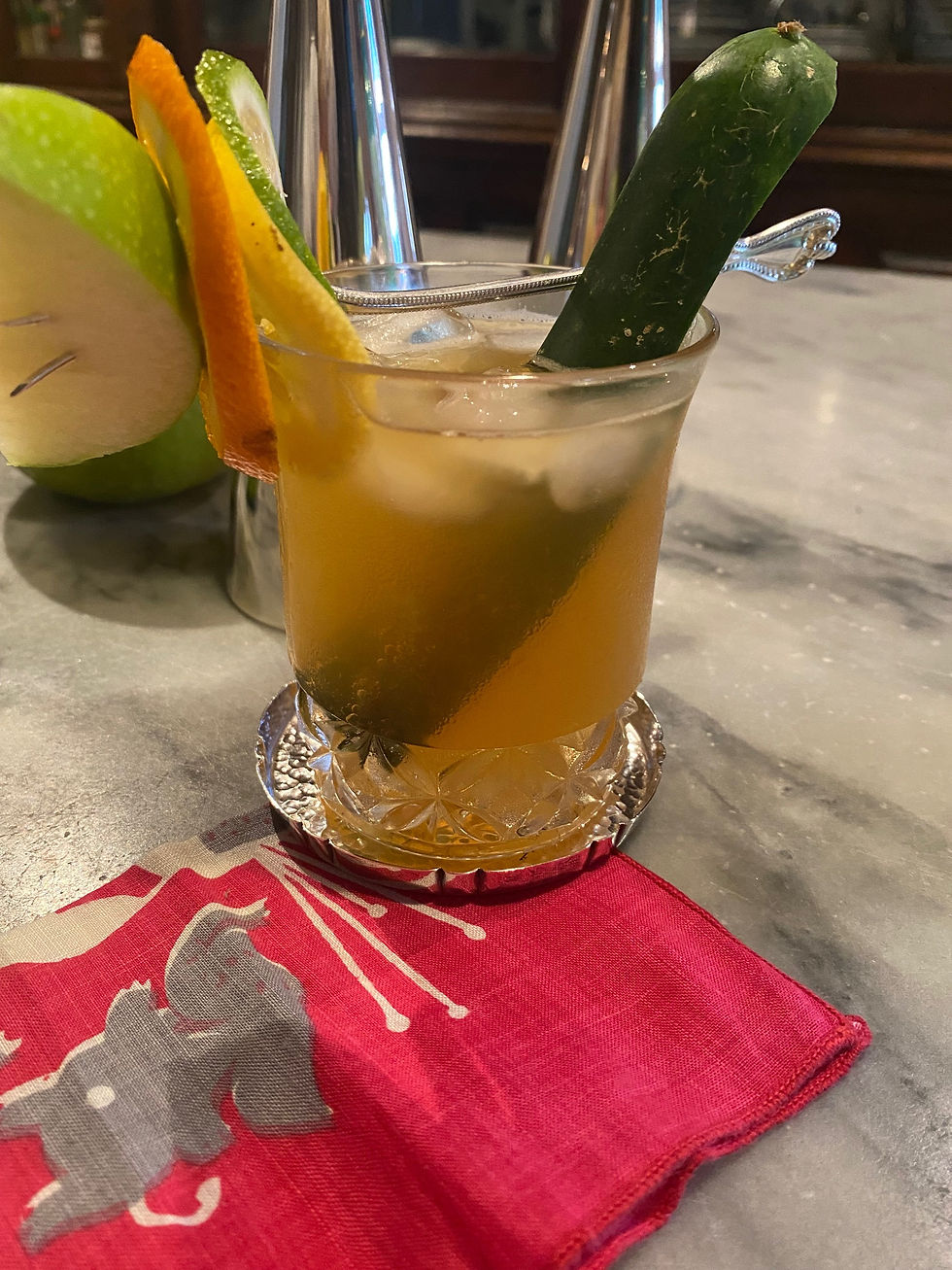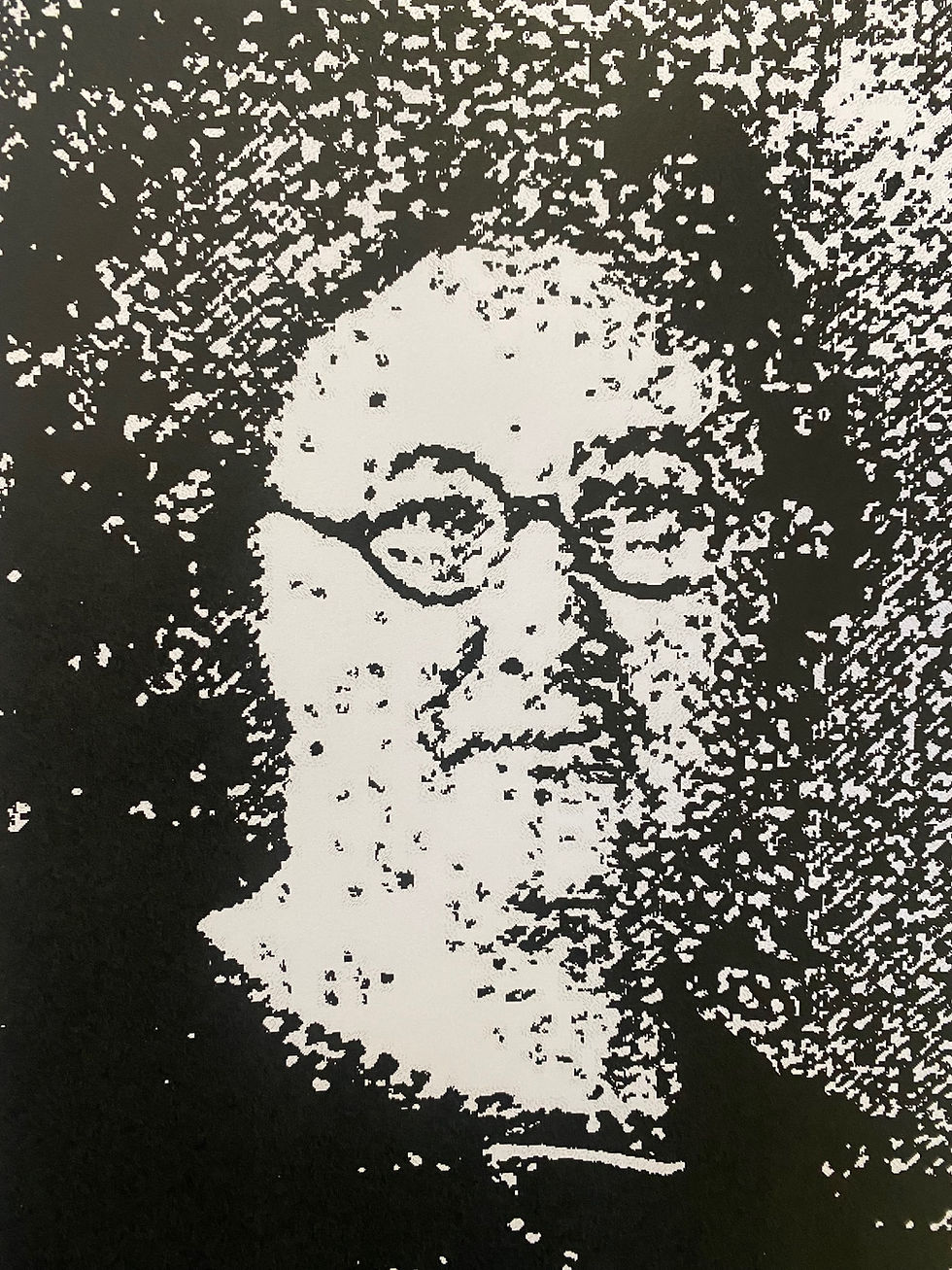Cocktail Hour: Gone Global
- jvannette5
- Jul 21, 2022
- 6 min read
Updated: Jul 26, 2022

Image credit: The Napoleon House, NOLA
“Cocktails and storytelling go together like mixed drinks.” - Laura Carlson, The Feast podcast
When it comes to cocktail history, there are a thousand good stories, and the truth is not necessary to most yarn-spinners. Let’s try to untangle a bit of lore and history around drinks so popularized that Americans claim them even though their histories and influence are global.
It’s British. It’s American. It’s NOLA’s. No it’s Not.

The herbed gin called Pimm’s No. 1 was invented in London by James Pimm, owner of the London Oyster Bar. As you can guess by the “No. 1” there are other infused versions of the gin, but the most popular has remained Pimm’s No. 1. But this isn’t a liquor lesson; it’s a cocktail history and that means we need to add mixers.
The Pimm’s Cup, now sometimes called the Pimm’s Original, adds citrus fruit, strawberries, cucumber, and mint, all topped with a fizzy lemonade. This drink originated in the UK, which might make sense to us since James Pimm invented the gin in London, but thanks to colonialism the drink spread across the globe and one day, a New Orleans bartender offered a version of the drink, and NOLA claimed it as their own.
The story goes that The Napoleon House wanted a drink that satisfied thirsty visitors in the hot, humid climate, but they didn’t want patrons to get too drunk too quickly lest they stop buying. Pimm’s No. 1 provided the answer since it is only 25% alcohol by volume. The NOLA version also adds fruit and fizzy lemonade, so a pop like Sprite, 7UP or Squirt. But the NOLA Pimm’s Cup generally leaves out the mint and loads up the fruit.
Wherever You Roam
We aren’t sure if Pam Stump was inspired by her own travels or if she learned it from a friend, but this is a great example of how recipes travel. The NOLA style found its way into Savoring Saginaw.

Pam Stump’s Pimm’s Cup
2 oz. Pimm’s No. 1
1 oz. gin
Diet Squirt
Cucumber stick
Green apple wedge, orange slice, lemon slice, lime slice
In tall glass with ice, add Pimm’s, gin and fill with diet Squirt. Add long cucumber stick (with peel) for stirring. Garnish with fruit on a skewer. Makes 1.
Pam Stump: Stirring Art
“Art is an act of love. You do because it is a way of communicating to anyone who wants to listen. If I could make one piece of sculpture say something the way art has touched me, I would feel it has all been worthwhile.”
Pamela Stump Walsh quoted in The Saginaw News, January 10, 1965

Pamela Stump was an artist and teacher. Although accomplished in numerous mediums, she is most often recognized for her sculptures. Much of her life was spent in the Detroit area; however, Saginaw was her home for many years. Her work is found in collections throughout the country. Numerous examples in Saginaw record her lasting connection to the community and may be seen at the Dow Event Center, Saginaw’s St. Paul Episcopal Church, the former Douglas MacArthur High School, SVSU, Delta College and several other locations and private collections.
Born in 1928, her 2007 Detroit Free Press obituary, provides an outline of her life:
“Born in Detroit, she attended Kingswood School Cranbrook for Girls on a 4-year scholarship. She graduated from the University of Michigan College of Architecture and Design with a bachelor's degree in 1950 and a master's degree a year later. That same year, she married David Walsh, a pilot and engineer in the Air Force, and started raising a family while they crisscrossed the country.
After the couple divorced, she returned to school, received a teaching degree from U-M in 1968, and began instructing at Cranbrook Schools in Bloomfield Hills a year later. She retired in 1990.
“As a teacher, she encouraged her students to express their independence and use their imaginations,” said her second husband, Richard White, whom she married in 1989.”
Her work is varied, complicated and intriguing. A description of her personality from a Saginaw News article captures an essential element of work:
“She calls herself both persistent ("an artist has to be") and impatient. Noticing the paradox, she laughs. "I am always changing. What I want one moment Is not what I want the next." She is gracious without effort because she is first of all trying to be a good person.” The Saginaw News, January 10, 1965
In 1950 she married David E. Walsh, an architect born in Kalamazoo. When he accepted a position with Glenn “Red” Beach in 1956, they moved to Saginaw. Pamela exhibited throughout the state and her work was regularly featured in exhibits at the Saginaw Museum – now the Saginaw Art Museum, where she also taught classes. Her entry in a 1964 area art show was described by Saginaw News arts writer James W. Henderson:
“Saginaw’s Pamela Stump Walsh, a frequent winner here and in many other shows in Michigan and elsewhere won the John D. Mershon Best of Show Award with here steel and brass sculpture “Goat.” With more realism than many of her works, the figure is intricate, strong in character and appealingly representational.”
She was passionate about human rights, While a member of the Saginaw Junior League her focus was Civil Rights, and the Saginaw News stated: “as with everything else, she will not back down on her convictions.” She refused a Saginaw commission when the client objected to her inclusion of an African American figure. Her obituary in the Detroit News records “During the Detroit riots she opened her home as a refuge for African American students at Oakland University.” The Detroit Free Press noted: “A central theme in many of her works portrayed the triumphs and struggles of women.”
Although she moved away from Saginaw, she maintained connections and friendships in her former home city. In 1972, the Saginaw Junior League commissioned
her to create the Comedy and Tragedy masks that grace the courtyard outside the Heritage Theater Lobby in the newly completed Saginaw Civic Center – now the Dow Event Center.
She passed away on February 18, 2007.
Boogie Woogie Cuba Libre

War has long contributed to the movement of food culture around the world. Two wars influenced the popularity of the humble Rum and Coke, also known as the Cuba Libre. Lore has it that the Cuba Libre - rum, coke, and a bit of lime - came to us through the Spanish-American War and the toast, “Por Cuba Libre!” or “To a free Cuba!” It’s plausible. And surely people have mixed rum and Coke for a long time.
But, when it really becomes a thing is due to WWII and the Andrews Sisters.
The Caribbean, though not often thought of, was a front in WWII, and the US had a military base in Trinidad (as well as many other island nations). Coca-Cola expressed its patriotism by promising to supply G.I.’s with Coke wherever they were. And the company kept its promise. Cases of Coke went with U.S. soldiers. Rum, being a drink that originated in the Caribbean, was plentiful.
In Trinidad, there was a catchy calypso tune which Trinidadian singer Lord Invader had reworked into a song that reflected the soldiers “off-duty activities.” It was a hit with locals and G.I.’s alike. The lyrics go:
Since the Yankee came to Trinidad,
They have the young girls going mad,
The young girls say they treat them nice,
And they give them a better price.
They buy rum and Coca-Cola,
Go down Point Koomhana
Both mother and daughter
Workin’ for the Yankee dollar.
Then, in 1944, the Andrew Sisters had finished recording in New York and rather than take a break, they recorded what they viewed as a silly song, “Rum and Coca-Cola.” Radio networks had some stress about playing the song, partly due to the lyrics and the light that painted the soldiers in, and partly because it meant Coca-Cola would get free advertising every time the song played.
Despite the worries, “Rum and Coca-Cola” became such a hit, it was “called the national anthem of the GI camps. And soon rum and Coke became the de facto national drink of many of the troops” (Curtis, 70). While many know the Andrews Sisters for “Boogie Woogie Bugle Boy,” on USO Tours “Rum and Coca-Cola” became their most requested song.
One Last Word about Pam Stump
The Kingswood School Cranbrook has one of Pam Stump's sculptures titled “Girl Reading or Suki.” Although executed after Pamela Stump Walsh left Saginaw, it has a unique Saginaw connection. Commissioned by the Kingswood School class of 1947, the work was created in memory of Suzanne Anderson Stenglein (born 1928, Vincennes, IN; died 1968, Saginaw, MI) whose husband was Harold Stenglein Jr. (Harold Stenglein’s mother was a coinventor of Spic and Span. However, that is another story and another recipe.)
If you know of works by Pamela Stump in the Great Lakes Bay area, please contact Tom Trombley at 989-752-2861 ext. 304 or ttrombley@castlemueum.org. In the future, we will do another post featuring additional examples her work. So, plan to make another round of Pam Stump’s Pimm’s Cups.
Images in photo album:
Pam Stump Walsh’s 1972 Bronze sculpture of comedy and tragedy theater masks in the courtyard at the Dow Event Center; A crucifix on the exterior of St. Paul’s Episcopal Church was originally created in 1965 for Father D’onofrio’s Home for Boys which was located at 608 N. Warren Avenue.
We hope you have enjoyed the Cocktail Hour as much as we have these last few weeks. If you missed the other posts, follow these links: It's 5 O'clock Somewhere; Complications of the 18th Amendment; Shake, Rattle & Roll into a New Era.
Cheers!
Sources:
Wayne Curtis, “Rum and Coca-Cola: The Murky Derivations of a Sweet Drink and a Sassy World War II Song,” The American Scholar. Summer 2006, vol. 75, no. 3.
Savoring Saginaw
The Saginaw News













